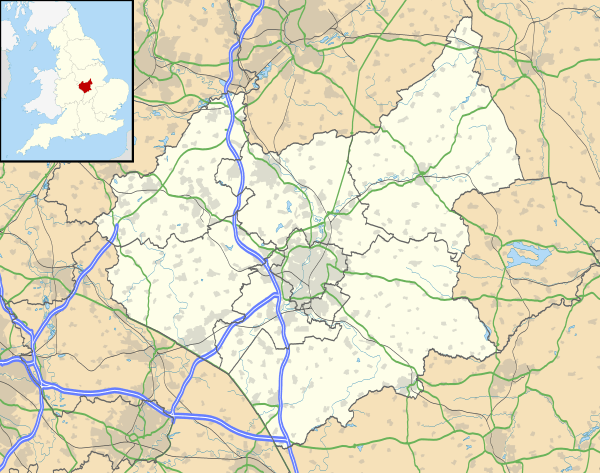Stoke Golding
Stoke Golding is a village and civil parish in the Hinckley and Bosworth district of Leicestershire, England, close to the county border with Warwickshire.[1] According to the 2001 census, the total population was 1,721 in just over 700 houses. The population at the 2011 census was 1,684 in 723 households.[2] The village is 16 miles (26 km) from the city of Leicester, about 3 miles (4.8 km) northwest of Hinckley and 4 miles (6.4 km) from Fenny Drayton. The village is bordered on one side by the Ashby Canal, well-used for recreational purposes.
| Stoke Golding | |
|---|---|
 Parish church of Saint Margaret | |
 Stoke Golding Location within Leicestershire | |
| Population | 1,684 (2011) |
| OS grid reference | SP399973 Stoke Golding |
| District | |
| Shire county | |
| Region | |
| Country | England |
| Sovereign state | United Kingdom |
| Post town | NUNEATON |
| Postcode district | CV13 |
| Dialling code | 01455 |
| Police | Leicestershire |
| Fire | Leicestershire |
| Ambulance | East Midlands |
| UK Parliament | |
History
Stoke Golding's unique historical claim to fame is that in 1485 the people of the village witnessed the unofficial rural coronation of Henry VII, the first Tudor monarch. His defeat of King Richard III, last of the Plantagenets, at the Battle of Bosworth marked the end of the Wars of the Roses, and heralded the accession to the throne of the Tudor dynasty of three Kings and two Queens. In so doing Stoke Golding claims to be the "Birthplace of the Tudor Dynasty".
After Henry Tudor was victorious over Richard III at the Battle of Bosworth, which took place in the healthy marshland known as the Redemore between Stoke Golding, Dadlington, Shenton and Sutton Cheney, Henry's entourage retired to hilly ground near the village of Stoke Golding. Here the impromptu coronation of King Henry VII was performed with a circlet by tradition retrieved from a nearby thorn bush. This area became known as Crown Hill and Crownhill Field.
Historical local accounts of the Battle of Bosworth field tell of the villagers climbing on to the battlements of the church of St Margaret of Antioch to view the bloody battle on 22 August 1485. The window sills of the Church show grooves which legend has it were caused by the soldiers sharpening their swords and axes on the eve of the battle. After the fighting, large pits were dug around Stoke Golding and the villages of Dadlington and Fenny Drayton, the nearest villages to the complete site of the battlefield, for the burial of the dead. King Henry VII then rewarded some of his followers and knighted the more senior of his supporters.
Facilities
Stoke Golding has an impressive Grade I listed Saxon church, that of St Margaret of Antioch, a Church of England church in the Diocese of Leicester. The church is roughly in the centre of the village and is a good example of the churches of that period. There is a Methodist church in the village that was first opened in 1857.
Three pubs and The Stoke Golding Club have regular entertainment.
There is a small independent village shop and also a hairdressers, both in the centre of the village. The village post office closed some time ago.
Transport facilities include a local bus hourly (except Sundays) to Nuneaton and Hinckley.
Schools
The primary school children (4 years to 11 years) of Stoke Golding and nearby villages mostly attend St Margaret's Church of England Primary School that is located next to the church within the village. St Martin’s Catholic Voluntary Academy is a secondary school located in the village.
Sport
A short lived greyhound racing track was opened on 19 April 1930. The racing was independent (not affiliated to the sports governing body the National Greyhound Racing Club) and was known as a flapping track, which was the nickname given to independent tracks.[3] The racing was run by the Stoke Golding Greyhound Association and the main race distance was 450 yards.[4]
Notable people

- Francis Brokesby
- Martine Croxall, news presenter on BBC News
- Sir William Edge, 1st Baronet
- Sir Henry Firebrace
- William Burdett, Frame Work Knitter
References
- OS Explorer Map 232 : Nuneaton & Tamworth: (1:25 000) :ISBN 0 319 46404 0
- "Civil Parish population 2011". Neighbourhood Statistics. Office for National Statistics. Retrieved 21 June 2016.
- Barnes, Julia (1988). Daily Mirror Greyhound Fact File, page 419. Ringpress Books. ISBN 0-948955-15-5.
- "Stoke Golding". Greyhound Racing Times.
External links
| Wikimedia Commons has media related to Stoke Golding. |
- Link showing details of Scouting in the Village
- Stoke Golding village website
- The annotated "Stoke Golding Country Dance"; English Folk Dance